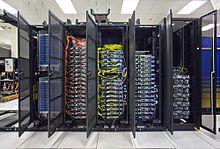A database machines or back end processor is a computer or special hardware that stores and retrieves data from a database. It is specially designed for database access and is coupled to the main (front-end) computer(s) by a high-speed channel. The database machine is tightly coupled to the main CPU, whereas the database server is loosely coupled via the network. Database machines can transfer large packets of data to the mainframe using hundreds to thousands of microprocessors with database software. The front end processor receives the data and displays it. The back end processor on the other hand analyzes and stores the data from the front end processor. Back end processors result in higher performance, increasing host main memory, increasing database recovery and security, and decrease of cost to manufacture. The database machine contrasts with a database server, which is a computer in a local area network that holds a database.
According to Julie A. McCann, "Currently a DBMS controls the organisation, storage and retrieval of data whilst regulating the security and integrity of the database, it accepts requests for data from the application programs and instructs the operating system (OS) to transfer the appropriate data."[1]
An example is the IBM System/38.
References
- ^ Mccann, Julie A. (2002-12-19). "The Database Machine: Old Story, New Slant?". ResearchGate.
See also
- Oracle Exadata
- Content Addressable File Store (CAFS)
This article is based on material taken from the Free On-line Dictionary of Computing prior to 1 November 2008 and incorporated under the "relicensing" terms of the GFDL, version 1.3 or later.
